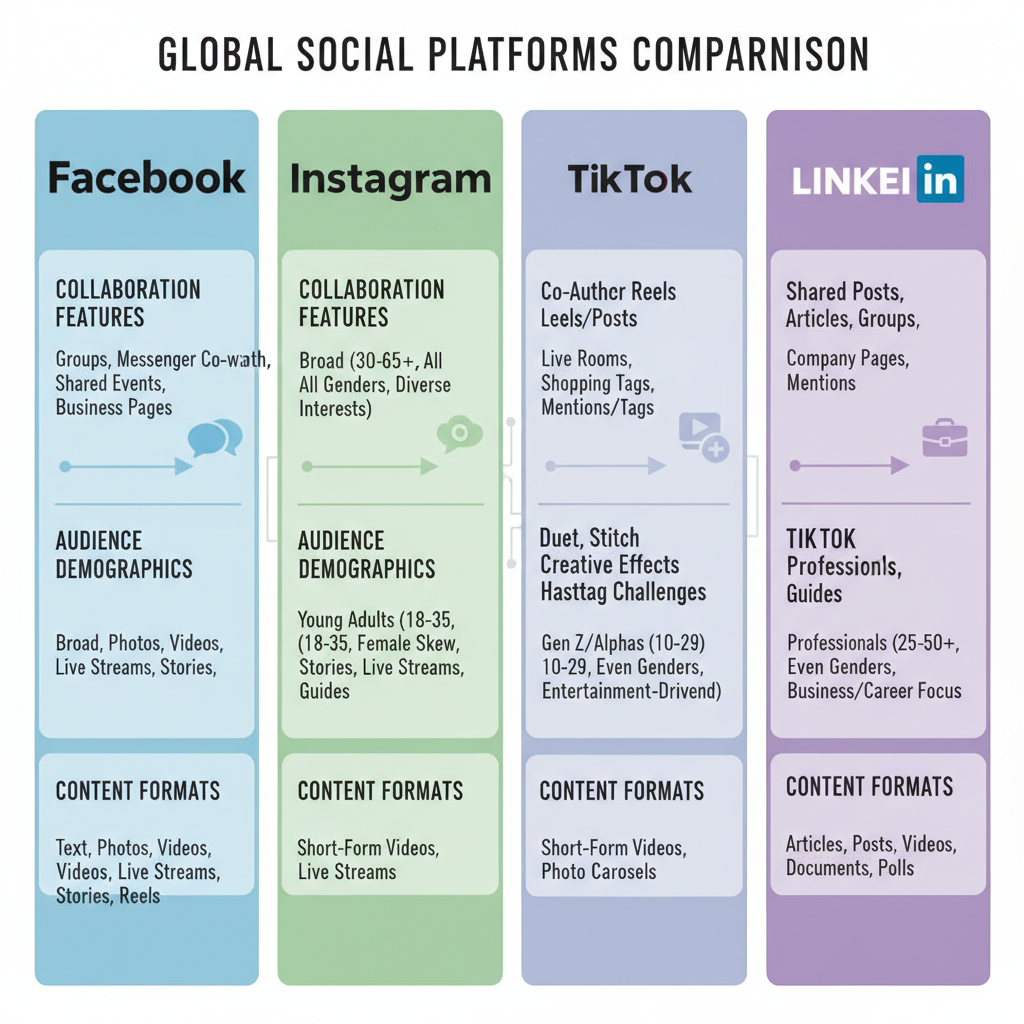Social Media and Collaboration Strategies for Brands
Learn actionable social media collaboration strategies for brands, from choosing platforms to vetting partners, to drive reach and measurable growth.

Social Media and Collaboration Strategies for Brands
In today’s fast‑paced digital world, social media and collaboration strategies for brands are essential for expanding reach, building credibility, and driving measurable growth. By partnering with creators, influencers, and other brands, you can amplify your message, tap into new audiences, and create mutually beneficial campaigns. This guide explains practical steps to understand, plan, and execute powerful social media collaborations for maximum ROI.

---
Understanding Collaboration in the Social Media Context
Collaboration in social media means working together across platforms, teams, or organizations to produce and distribute shared content, events, or campaigns. It can occur in several forms:
- Cross‑platform: Leveraging multiple channels like Instagram, TikTok, LinkedIn, and YouTube to spread joint messages.
- Cross‑team: Aligning internal marketing, product, and customer success teams with external influencers, partner brands, or media outlets.
A successful collaboration blends the strengths of each participant so the message resonates with both audiences — creating a unified brand experience that drives engagement and loyalty.
---
Identifying Objectives Before Partnering
Before seeking collaborators, define why you want to partner. Clear objectives help select the right partners, content formats, and KPIs.
Common goals include:
- Audience Growth – Expand reach into new demographics or geographies.
- Brand Awareness – Build recognition for products or services.
- Lead Generation – Drive sign‑ups, inquiries, or purchases.
- Community Engagement – Boost likes, comments, shares, DMs, and other interactions.
With defined goals, targeting becomes sharper and measurement more accurate — ensuring you can optimize future collaboration strategies.
---
Choosing the Right Platforms
Different platforms excel for different collaboration results. Choosing the right ones is key to success.
| Platform | Best For | Strengths |
|---|---|---|
| Visual storytelling, influencer campaigns | High engagement rates, Stories & Reels for creativity | |
| B2B networking, thought leadership | Professional audience, long‑form content reach | |
| TikTok | Viral trends, youth engagement | Short videos, high organic discoverability |
| YouTube | Tutorials, reviews, long‑form entertainment | Strong SEO potential, evergreen content |
Align platform selection with objectives: LinkedIn is optimal for B2B thought leadership, while Instagram and TikTok drive consumer engagement through visuals and interactive trends.

---
Finding and Vetting Potential Collaborators
Identifying the right collaborator requires detailed research:
- Engagement Rate – Average likes, comments, and shares indicate genuine interest.
- Content Quality – Measure relevance, aesthetics, and production value.
- Values Match – Check synergy in brand voice, ethics, and mission.
- Audience Overlap – Ensure follower profiles align with target customers.
Tools like Upfluence, AspireIQ, or manual audits can vet candidates. Always verify authentic engagement to avoid wasting resources on inflated metrics.
---
Establishing Roles, Timelines, and Communication Channels
Once you’ve confirmed a partner, formalize the collaboration:
- Roles: Decide who handles creative direction, posting, and engagement.
- Timelines: Create clear schedules for production, approval, and publishing.
- Communication Channels: Use Slack, Teams, or dedicated WhatsApp groups.
- Shared Docs: Store scripts, captions, and assets in Google Docs/Sheets.
- Project Management Tools: Track progress in Trello, Asana, or Monday.com.
A robust organizational framework eliminates misunderstandings and maintains momentum.
---
Creating Co‑Branded Content Strategies
Joint content is the heart of social media collaboration. Effective formats include:
- Joint Live Sessions – Q&A or panel streams to both audiences.
- Co‑Authored Posts – Share curated posts tagged to each brand.
- Guest Takeovers – Let collaborators run your account briefly.
- Tutorial Exchanges – Create guides or demos highlighting each other’s expertise.
Clearly communicate the added value for both followings to maximize engagement.
![content collaboration]()
---
Using Hashtags, Mentions, and Cross‑Promotion
Enhance discoverability with:
- Branded Hashtags – Unique campaign tags enable tracking of user‑generated content.
- Mentions (@) – Tag partners in each post to signal joint effort.
- Cross‑Promotion – Repurpose assets across partner profiles with custom captions.
- Story & Post Tagging – Use features like Instagram Collab to appear on both feeds.
Such tactics ensure collaborative content lands before the widest possible audience.
---
Scheduling and Promoting Collaborative Campaigns
Strategic timing boosts campaign impact:
- Teasers – Hint at upcoming collabs via cryptic posts or BTS clips.
- Launch Day – Publish simultaneously on chosen platforms.
- Follow‑Ups – Share updates on milestones, participation, or wins.
Leverage native scheduling or tools like Buffer and Later to retain consistency.
---
Tracking Key Metrics Together
Measurement provides insight for optimization. Focus on:
| Metric | Purpose | Tools |
|---|---|---|
| Reach | Shows how many users view the content | Platform analytics, Google Data Studio |
| Engagement | Measures interaction rate | Native insights, Sprout Social |
| Clicks | Indicates interest in CTAs | Bitly, UTM tracking |
| Conversions | Records completed business goals | CRM systems, e‑commerce analytics |
Analyze results jointly to identify strengths, weaknesses, and priorities for the next campaign.
---
Iterating and Building Long‑Term Partnerships
The real power of social media collaboration is sustainability:
- Review successes and gaps candidly.
- Gather audience feedback for refinement.
- Plan recurring events (e.g., quarterly joint webinars).
- Explore deeper integrations like affiliate programs or co‑product development.
Consistently nurturing relationships builds trust, increases shared audiences, and strengthens brand equity.
---
Summary & Next Steps
Effective social media and collaboration strategies can deliver lasting value when they are goal‑driven, well‑planned, and continuously evaluated. From identifying objectives to selecting platforms, vetting partners, creating co‑branded content, and tracking metrics, every step contributes to sustainable growth. Apply these best practices to your next campaign, and watch your brand benefit from the power of collaborative marketing.
Ready to elevate your reach? Start exploring potential collaborators today and implement a strategic plan that drives success for all involved.


